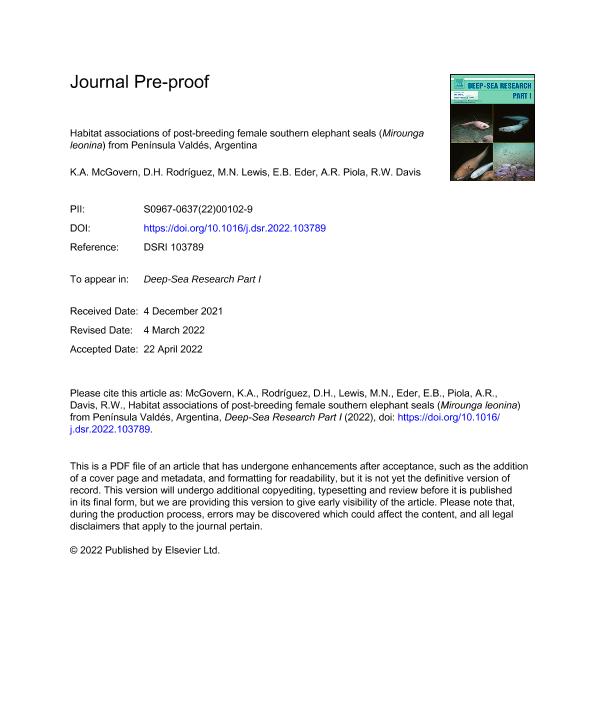Mostrar el registro sencillo del ítem
dc.contributor.author
McGovern, K.A.
dc.contributor.author
Rodriguez, Diego Horacio

dc.contributor.author
Lewis, Mirtha Noemi

dc.contributor.author
Eder, Elena Beatriz

dc.contributor.author
Piola, Alberto Ricardo

dc.contributor.author
Davis, R.W.
dc.date.available
2023-07-07T19:34:56Z
dc.date.issued
2022-05
dc.identifier.citation
McGovern, K.A.; Rodriguez, Diego Horacio; Lewis, Mirtha Noemi; Eder, Elena Beatriz; Piola, Alberto Ricardo; et al.; Habitat associations of post-breeding female southern elephant seals (Mirounga leonina) from Península Valdés, Argentina; Pergamon-Elsevier Science Ltd; Deep Sea Research Part I: Oceanographic Research Papers; 185; 103789; 5-2022; 1-13
dc.identifier.issn
0967-0637
dc.identifier.uri
http://hdl.handle.net/11336/202801
dc.description.abstract
Research on marine mammal habitat-associations often uses satellite remote sensing of sea surface temperature, chlorophyll concentration, and sea surface height to map mesoscale features, which may indicate areas of enhanced productivity and prey availability. However, for species that feed at depths >400 m, the increased productivity associated with mesoscale features observed near the surface may have little or no immediate effect on habitat-associations at depth. As a result, previous studies have found a weak correlation between mesoscale features and the movements of marine mammals. The advantage of biologging is that hydrographic variables are recorded in situ and at foraging depths using animal-borne instruments with sensors for temperature, conductivity (salinity), and dissolved oxygen. The goal of this study was to characterize the habitat-associations of female southern elephant seals (SES) from Península Valdés, Argentina during the post-breeding foraging trip. Although female SES exhibited significant habitat-associations with sea surface height anomaly and chlorophyll concentrations, the presence or absence of eddies was not predictive of foraging behavior, and the majority of foraging dives (74%) and prey encounters (77%) occurred in the absence of eddies. The strongest habitat-association was with deep (>500 m) and cold (3.73 ± 1.29 °C) subantarctic water, primarily during foraging dives from dusk to dawn. Female SES made most of their foraging dives (68%, mean maximum depth of 539 ± 226 m) and had the most prey encounters (67%) in Antarctic Intermediate Water (AAIW), which is formed near the Subantarctic Front on the northern flank of the Antarctic Circumpolar Current. Our results suggest that AAIW is the principal foraging habitat of female SES from Península Valdés, which may not be directly associated with near-surface mesoscale features. Future research on the habitat-associations for SES and other deep-diving marine mammals should focus on indices of foraging success and the hydrographic features of water masses at foraging depths, not mesoscale features observed near the surface.
dc.format
application/pdf
dc.language.iso
eng
dc.publisher
Pergamon-Elsevier Science Ltd

dc.rights
info:eu-repo/semantics/openAccess
dc.rights.uri
https://creativecommons.org/licenses/by-nc-nd/2.5/ar/
dc.subject
ANTARCTIC INTERMEDIATE WATER
dc.subject
DIVING ELEPHANT SEAL
dc.subject
FORAGING HABITAT-ASSOCIATION
dc.subject
PENÍNSULA VALDÉS
dc.subject.classification
Oceanografía, Hidrología, Recursos Hídricos

dc.subject.classification
Ciencias de la Tierra y relacionadas con el Medio Ambiente

dc.subject.classification
CIENCIAS NATURALES Y EXACTAS

dc.title
Habitat associations of post-breeding female southern elephant seals (Mirounga leonina) from Península Valdés, Argentina
dc.type
info:eu-repo/semantics/article
dc.type
info:ar-repo/semantics/artículo
dc.type
info:eu-repo/semantics/publishedVersion
dc.date.updated
2023-07-06T22:04:17Z
dc.journal.volume
185
dc.journal.number
103789
dc.journal.pagination
1-13
dc.journal.pais
Países Bajos

dc.journal.ciudad
Amsterdam
dc.description.fil
Fil: McGovern, K.A.. Texas A&M University; Estados Unidos
dc.description.fil
Fil: Rodriguez, Diego Horacio. Universidad Nacional de Mar del Plata, Facultad de Ciencias Exactas y Naturales, Instituto de Investigaciones Marinas y Costeras; Argentina
dc.description.fil
Fil: Lewis, Mirtha Noemi. Consejo Nacional de Investigaciones Científicas y Técnicas. Centro Científico Tecnológico Conicet - Centro Nacional Patagónico. Centro para el Estudio de Sistemas Marinos; Argentina
dc.description.fil
Fil: Eder, Elena Beatriz. Consejo Nacional de Investigaciones Científicas y Técnicas. Centro Científico Tecnológico Conicet - Centro Nacional Patagónico. Centro para el Estudio de Sistemas Marinos; Argentina
dc.description.fil
Fil: Piola, Alberto Ricardo. Consejo Nacional de Investigaciones Científicas y Técnicas; Argentina. Ministerio de Defensa. Armada Argentina. Servicio de Hidrografía Naval; Argentina. Instituto Franco-Argentino sobre Estudios del Clima y sus Impactos; Argentina. Universidad de Buenos Aires. Facultad de Ciencias Exactas y Naturales. Departamento de Ciencias de la Atmósfera y los Océanos; Argentina
dc.description.fil
Fil: Davis, R.W.. Texas A&M University; Estados Unidos
dc.journal.title
Deep Sea Research Part I: Oceanographic Research Papers

dc.relation.alternativeid
info:eu-repo/semantics/altIdentifier/doi/http://dx.doi.org/10.1016/j.dsr.2022.103789
dc.relation.alternativeid
info:eu-repo/semantics/altIdentifier/url/https://www.sciencedirect.com/science/article/pii/S0967063722001029
Archivos asociados
